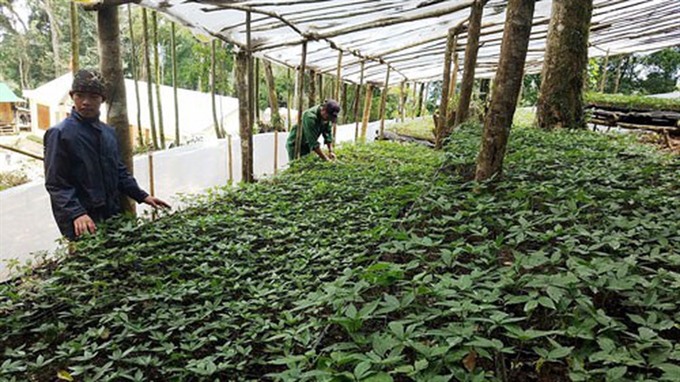 Society
Society

Ethnic minority communities that live primarily on agricultural and forest land have been able to increase their incomes, raise their voices and promote their contributions to the protection and management of community forest land.
 |
| Ngọc Linh Gingseng growing in Tu Mơ Rông District of Kon Tum Province. – Photo baomoi.com.vn |
HÀ NỘI — Ethnic minority communities that live primarily on agricultural and forest land have been able to increase their incomes, raise their voices and promote their contributions to the protection and management of community forest land.
This was one of the achievements of the project “Promoting Land Rights for Ethnic Minority People in Việt Nam,” which was presented at a review workshop in Hà Nội today.
Funded by the European Union, the project has conducted dozens of policy dialogues at all levels over three years, significantly contributing to the inclusion of community rights in the ownership and management of forest land in the 2018 Forestry Law.
In the Tây Nguyên (Central Highlands) province of Kon Tum, for example, the project supported local authorities in handing over the ownership certificate for more than 500ha of forest land to the Xê Đăng ethnic community to protect and manage the forest.
“Thanks to the project, my commune received ownership of more than 500 hectares of community forest land,” said Phạm Xuân Quang from Tu Mơ Rông District in Kon Tum Province – one of the areas with communities participating in the project. “And the villagers had the chance to take part in many workshops and meet with officials at the central level and National Assembly representatives to share our concerns related to community forest land.”
It also enabled ethnic minority communities such as the Vân Kiều, Thái, Xê Đăng, Rơ Ngao and Dao Đỏ groups in the provinces of Lào Cai, Nghệ An, Hà Tĩnh, Quảng Bình and Kon Tum to develop forest-based livelihoods resilient to climate change that will provide a long-term source of income.
The ethnic minority groups were also given assistance to earn stable income through production. Some examples are the Ngọc Linh Gingseng gardens for Xê Đăng people in Tu Mơ Rông District and planting medicinal herbs in Đồng Văn Commune of Nghệ An Province.
During this process, the project helped ethnic minority women gain confidence and enhanced their role in their families and communities.
“Many ethnic minority communities live entirely on forests,” said Trần Thị Hoa, director of the Centre for Culture Identity and Resources Use Management (CIRUM). “Only by managing, protecting and exploiting the forests in a sustainable way can they improve their lives.”
Lê Thị Kim Dung, country director of CARE International in Việt Nam, said poverty among ethnic minority communities persisted more and lasted longer than in the majority Kinh people.”
“Ethnic minority women encounter a lot more barriers to enhancing their status and voice,” Dung said. This was the reason for CARE’s focus on improving gender equality in all project areas.
The project also enhanced the capacity of local authorities and relevant networks including LandNet – a member network advocating for the land rights of the (mainly) ethnic minority peoples living in forest and forest margin areas of upland Việt Nam and Laos – and the Livelihood Sovereignty Alliance (LISO).
In the advocacy process, the project co-operated with the Vietnam Union of Science and Technology Associations (VUSTA), the Forest Land Coalition (ForLand) and the Ethnic Minority Working Group (EMWG).
The project was funded by the European Union and co-implemented by CIRUM and CARE in Việt Nam from 2016 to 2018.
The project made great progress towards its overall objective of contributing to the protection and promotion of ethnic minority people’s rights to community forest lands in Việt Nam. — VNS




